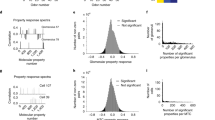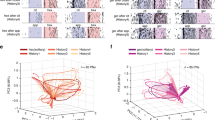Abstract
Chronic single-unit recordings were obtained from the mitral celllayer of the olfactory bulbs of awake freely moving rats placed in anodorant stream. Over periods up to five days, 618 recordings from 186single neurons were obtained. Responses of individual neurons werefound to be quite variable over time, although this variability wasbelow chance and was not incremental. The responses of nearbyneurons were more similar than expected by chance but less similarthan individual neurons recorded at different times. However,responses of spatially well-separated neurons were more differentthan chance over short time periods. During rapid sniffing,single-unit responses became more variable, and the spatialorganization of responses became less apparent. These results suggestthat neuronal responses in the olfactory bulb are generally quitevariable over time, with this variability increasing during periodsof rapid sniffing. These results are interpreted in the context of adistributed, centrally modulated model of olfactoryprocessing.
Similar content being viewed by others
References
Alberts JR, Galef BG, Jr. (1971) Acute anosmia in the rat: A behavioral test of a peripherally induced olfactory deficit. Physiol. Behav.6:619–621.
Arieli A, Sterkin A, Grinvald A, Aertsen A (1996) Dynamics of ongoing activity: Explanation of the large variability in evoked cortical responses. Science273:1868–1871.
Astic L, Saucier D, Holley A (1987) Topgraphical relationships between olfactory receptor cells and glomerular foci in the rat olfactory bulb. Brain Res.424:144–152.
Baldi P, Heiligenberg W (1988) How sensory maps could enhance resolution through ordered arrangments of broadly tuned receivers. Biol. Cybern.59:313–318.
Bhalla US, Bower JM (1993) Exploring parameter space in detailed single neuron models: Simulations of the mitral and granule cells of the olfactory bulb. J. Neurophysiol.69(6):1948–1965.
Bialek W, Rieke F (1992) Reliability and information transmission in spiking neurons. Trends Neurosci.15(11):428–434.
Bower JM (1995) Reverse engineering the nervous system: An in vivo, in vitro, and in computoapproach to understanding the mammalian olfactory system. 2nd edition. In: S Zornetzer, J Davis, C Lau, eds. An Introduction to Neural and Electronic Networks, Academic Press, New York. pp. 3–28.
Buck L (1996) Information coding in the vertebrate olfactory system. Annu. Rev. Neurosci.19:517–544.
Buck L, Axel R (1991) A novel multigene family may encode odorant receptors: A molecular basis for odor recognition. Cell65:175–187.
Buonviso N, Chaput MA (1990) Response similarity to odors in olfactory bulb output cells presumed to be connected to the same glomerulus: Electrophysiological study using simultaneous single-unit recordings. J. Neurophysiol.63:447–454.
Buonviso N, Chaput MA, Berthommier F (1992) Temporal pattern analyses in pairs of neighboring mitral cells. J. Neurophysiol. 68:417–424.
Chaput MA (1986) Respiratory-phase-related coding of olfactory information in the olfactory bulb of awake freely-breathing rabbits. Physiology and Behavior36:319–324.
Chaput MA, Holley A (1979) Spontaneous activity of olfactory bulb neurons in awake rabbits with some observations on the effects of pentobarbitol anesthesia. J. Physiol. Paris75:939–948.
Chaput MA, Holley A (1985) Responses of olfactory bulb neurons to repeated odor stimulations in awake freely-breathing rabbits. Physiol. and Behav.34:249–258.
Chaput MA, Lankheet MJ (1987) Influence of stimulus intensity on the categories of single-unit responses recorded from olfactory bulb neurons in awake freely breathing rabbits. Physiology and Behavior40:453–462.
Chaput MA, Buonviso N, Berthommie F (1992) Temporal patterns in spontaneous and odour-evoked mitral cell discharges recorded in anaesthetized freely breathing animals. Eur. J. Neuroscience 4:813–822.
Chess A, Simon I, Cedar H, Axel R (1994) Allelic inactivation regulates olfactory receptor gene expression. Cell78:823–834.
Cinelli AR, Hamilton KA, Kauer JS (1995) Salamander olfactory bulb neuronal activity observed by video rate, voltage-sensitive dye imaging. III. Spatial and temporal properties of responses evoked by odorant stimulation. J. Neurophysiol. 73(5):2053–2071.
Cinelli AR, Salzberg BM(1992) Dendritic origin of late events in optical recordings from salamander olfactory bulb. J. Neurophysiol. 68:786–806.
Devor M (1976). Fiber trajectories of olfactory bulb efferents in the hamster. J. Comp. Neurol.166:31–48.
Dickinson TA, White J, Kauer JS, Walt DR (1996) A chemical detercting system based on a cross-reactive optical sensory array. Nature382:697–700.
Duchamp-Viret P, Duchamp A, Sicard G (1990) Olfactory discrimination over a wide concentration range: Comparison of receptor cell and bulb neuron properties. Brain Res.517:256–262.
Freeman WJ (1991) The physiology of perception. Scientific American 264(2):78–85.
Fujita SC, Mori KR, Imamura D, Obata K (1985) Subclasses of olfactory receptor cells and their segregated central projections demonstrated by a monclonal antibody. Brain Res.326:192–196.
Furster D, Spruston N (1995) Cracking the neuronal code. Science 270:756–757.
Gerstein GL, Aertsen AMHJ (1985) Representation of cooperative firing among simultaneously recorded neurons. J. Neurophys. 54:1513–1528.
Goldberg SJ, Moulton DG (1987) Olfactory bulb responses telemetered during an odor discrimination task in rats. Exp. Neurology 96:430–442.
Granger R, Ambros-Ingerson J, Lynch G (1988) Derivation of encoding characteristics of layer II cerebral cortex. J. Cogn. Neurosci. 1:64–91.
Gray CM, Skinner JE (1988) Centrifugal regulation of neuronal activity in the olfactory bulb of the waking rabbit as revealed by cryogenic blockade. Exp. Brain Res.69:378–386.
Graziadei PPC, Monti Graziadei GA (1979) Neurogenesis and neuron regeneration in the olfactory system of mammals. I. Morphological aspects of differentiation and structural organization of the olfactory sensory neurons. J. Neurocytol.8:1–18.
Haberly LB (1985). Neuronal circuitry in olfactory cortex: Anatomy and functional implications. Chemical Senses10:219–238.
Hamilton KA, Kauer JS (1985) Intracellular potentials of salamander mitral/tufted neurons in response to odor stimulation. Brain Res. 338:181–118.
Harrison TA, Scott JW (1986) Olfactory bulb responses to odor stimulation: Analysis of response pattern and intensity relationships. J. Neurophysiol.56:1571–1589.
Hasselmo ME, Bower JM (1993) Acetylcholine and memory. Trends in Neurosci.16:218–222.
Holley A Sicard G (1984) Receptor cell responses to odorants: Similarities and differences among odorants. Brain Res.292:283–296.
Imamura K, Mataga N, Mori K (1992) Coding of odor molecules by mitral/tufted cells in rabbit olfactory bulb. I. Aliphatic compounds. J. Neurophysiol. 68:1986–2002.
Jiang T, Holley A (1992) Some properties of receptive fields of olfactory mitral/tufted cells in the frog. J. Neurophysiol. 68:726–733.
Jourdan F, Duveau A, Astic L, Holley A (1980) Spatial distribution of 2-deoxyglucose uptake in the olfactory bulbs of rats stimulated with two different odors. Brain Res.188:139–154.
Katoh K, Koshimoto H, Tani A, Mori K (1993) Coding of odor molecules by mitral/tufted cells in rabbit olfactory bulb. II. Aromatic compounds. J. Neurophysiol.70:2161–2175.
Kauer JS (1974) Response properties of amphibian olfactory bulb neurones to odour stimulation. J. Physiol. Lond.243:695–715.
Kauer JS (1987) Coding in the Olfactory System. In: TE Finger, WL Silver, eds. Neurobiology of Taste and Smell. Wiley, New York.
Kauer JS (1988) Real-time imaging of evoked activity in local circuits of the salamander olfactory bulb. Nature331:166–168.
Kauer JS, Shepherd GM (1977) Analysis of the onset phase of olfactory bulb unit responses to odour pulses in the salamander. J. Physiol. Lond.272:495–516.
Keppel G (1982) Design and Analysis: A Researcher’s Handbook. 2nd edition. Prentice-Hall, New Jersey.
Kurahashi T, Lowe G, Gold GH (1994) Suppression of odorant responses by odorants in olfactory receptor cells. Science265:118–120.
Lancet D (1986) Vertebrate olfactory reception. Ann. Rev. Neurosci. 9:329–355.
Lancet D, Greer CA, Kauer JS, Shepherd GM (1982) Mapping of odor-related neuronal activity in the olfactory bulb by highresolution 2-deoxyglucose autoradiography Proc. Natl. Acad. Sci. 79:670–674.
Laurent G (1996) Odor images and tunes. Neuron16:473–476.
Laurent G, Davidowitz H (1994) Encoding of olfactory information with oscillating neural assemblies. Science265:1872–1875.
Lonergan MC, Severin EJ, Doleman BJ, Grubb RH, Lewis N (1996) Array-based vapor sensing using chemically sensitive carbon black-polymer resistors. Chem-mater88:2298–2312.
Macrides F, Chorover SL(1972) Olfactory bulb units: Activity correlated with inhalation cycles and odor quality. Science175:84–87.
Mainen ZF, Sejnowski TJ (1995) Reliability of spike timing in neocortical neurons. Science268:1503–1506.
Mair RG (1982) Response properties of olfactory bulb neurons. J. Physiol. Lond.326:341–359.
McNaughton BL, O’Keefe J, Barnes CA (1983) The stereotrode: A new technique for simultaneous isolation of several single units in the central nervous system from multiple unit records. J. Neurosci. Meth.8:391–397.
Meredith M (1986) Patterned response to odor in mammalian olfactory bulb: The influence of intensity. J. Neurophysiol.56:572–597.
Meredith M (1992) Sensory processing in the main and accessory olfactory systems: Comparisons and contrasts. J. Steroid Biochem. Molec. Biol.39(4B):601–614,(1991) 29:111–117.
Mori K (1987) Membrane and synaptic properties of identified neurons in the olfactory bulb. Progress in Neurobio.29:275–320.
Mori K, Mataga N, Imamura K (1992) Differential specificities of single mitral cells in rabbit olfactory bulb from a homologous series of fatty acid odor molecules. J. Neurophysiol.67:786–789.
Nicolelis MAL, Baccala LA, Lin RCS, Chapin JK (1995) Sensorimotor encoding by synchronous neural ensemble activity at multiple levels of the somatosensory system. Science268:1353–1358.
Pager J (1985) Respiration and olfactory bulb unit activity in the unrestrained rat: Statements and reappraisals. Behav. Brain Res. 16:81–94.
Press WH, Flannery BP, Teukolsky SA, Vetterling WT (1988) The Art of Scientific Computing. Cambridge University Press, Cambridge.
Rall W, Shepherd GM (1968) Theoretical reconstruction of field potentials and dendrodendritic synaptic interactions in olfactory bulb. J. Neurophysiol.31:884–915.
Rawson NE, Restrepo D (1995) Does a single olfactory neuron express one or more receptor genes? Soc. Neurosci. Abst.21:131.
Ressler KJ, Sullivan SL, Buck LB (1993) A Zonal Organization of odorant receptor gene expression in the olfactory epithelium. Cell 79:1245–1256.
Rumelhart DE, McClelland JL (1986) Parallel Distributed Processing. MIT Press, Cambridge, MA.
Scott JW (1977) Ameasure of extracellular unit responses to repeated stimulation applied to observations of the time course of olfactory responses. Brain Res.132:247–258.
Shadlen MN, Newsome WT (1994) Noise, neural codes and cortical organization. Curr Opinion Neurobiol. 4:569–579.
Shepherd GM (1993) Principles of specificity and redundancy underlying the organization of the olfactory system. Microscopy Research and Technique24:106–112.
Sicard G, Holley A (1984) Receptor cell responses to odorants: Similarities and differences among odorants. Brain Res.292:283–296.
Slotnick BM, Nigrosh BJ (1974) Olfactory stimulus control evaluated in a small animal olfactometer. Perceptual and Motor Skills 39:583–597.
Slotnick BM, Graham S, Laing DG, Bell GA (1987) Detection of propionic acid vapor by rats with lesions of olfactory bulb areas associated with high 2-DG uptake. Brain Res.417:343–346.
Slotnick BM, Kufera A, Silberberg AM (1991)Olfactory learning and odor memory in the rat. Physiol. and Behav.50:555–561.
Snedecor GW, Cochran WG (1967) Statistical Methods. 6th edition. Iowa State University Press, Ames.
Softky WR, Koch C (1993) The highly irregular firing of cortical cells is inconsistent with temporal integration of random EPSPs. J. Neurosci.13(1):334–350.
Stewart WB, Kauer JS, Shepherd GM (1979) Functional organization of rat olfactory bulb analyzed by the 2-deoxyglucose method. J. Comp. Neurol.185(4):715–734.
Vassar R, Chao SK, Sitcheran R, Nunez JM, Vosshall LB, Axel R (1994) Topographic organization of sensory projections to the olfactory bulb. Cell.79:981–991.
Wellis DP, Scott JW, Harrison TA (1989) Discrimination among odorants by single neurons of the rat olfactory bulb. J. Neurophysiol. 61:1161–1177.
Wilson DA, Leon M (1987) Evidence of lateral synaptic interactions in olfactory bulb output cell responses to odors. Brain Res. 417:175–180.
Youngentob SL, Mozell MM, Sheehe PR, Hornung DE (1987) A quantitative analysis of sniffing strategies in rats performing odor detection tasks. Physiol. and Behav.41:59–69.
Author information
Authors and Affiliations
Rights and permissions
About this article
Cite this article
Bhalla, U.S., Bower, J.M. Multiday Recordings from Olfactory Bulb Neurons in Awake Freely Moving Rats: Spatially and Temporally Organized Variability in Odorant Response Properties. J Comput Neurosci 4, 221–256 (1997). https://doi.org/10.1023/A:1008819818970
Issue Date:
DOI: https://doi.org/10.1023/A:1008819818970




